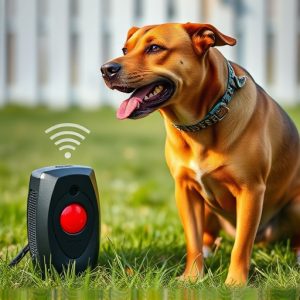Handheld Dog Deterrents: Effective Training with Safe Ultrasonic Tools
Understanding canine behavior is key for effective dog training, with handheld ultrasonic deterrents…….
Understanding canine behavior is key for effective dog training, with handheld ultrasonic deterrents offering a non-violent solution. These devices emit inaudible sound waves to startle dogs and correct unwanted actions like barking or aggression. They come with adjustable settings and convenient carrying methods for hands-free use at home or outdoors. Various carrying options, from lanyards to sticks, cater to different user needs. While effective, they may not work on all dogs and require consistent positive reinforcement training. Responsible use alongside other methods is vital to avoid over-reliance on electronic stimulation, with proper integration improving dog behavior through familiarization and positive associations.
“Unraveling the effectiveness of ultrasonic dog behavior correction tools, this comprehensive guide delves into understanding canine behavior and the precise role of ultrasonic devices. We explore how handheld dog deterrents work, highlighting their safety features for both pets and users. Key to optimal use are various carrying methods, which we dissect for effective deployment. With a balanced look at benefits and limitations, this article offers insights into integrating ultrasonic correction with positive reinforcement training.”
- Understanding Canine Behavior and the Role of Ultrasonic Devices
- How Handheld Dog Deterrent Devices Work and Their Safety Features
- Exploring Different Carrying Methods for Effective Use
- Benefits and Limitations: A Comprehensive Look at Ultrasonic Tools
- Training Tips: Integrating Ultrasonic Correction into Positive Reinforcement Strategies
Understanding Canine Behavior and the Role of Ultrasonic Devices
Canine behavior is complex and multifaceted, shaped by a mix of innate instincts, socialization, and environment. Understanding these factors is crucial when considering methods for positive dog behavior correction. Handheld dog deterrents, like ultrasonic devices, have gained popularity as non-violent training tools. These devices emit high-frequency sound waves that are inaudible to humans but can startle or discourage dogs from unwanted actions, such as barking excessively or jumping on people.
Ultrasonic devices offer a hands-free and remote carrying method for dog deterrents, allowing trainers to correct behavior without direct physical interaction. This technology is particularly useful for addressing specific behaviors like aggression, anxiety, or destructive tendencies. However, it’s important to note that ultrasonic devices should be used as a last resort and in conjunction with other positive reinforcement techniques to ensure effective and safe training methods.
How Handheld Dog Deterrent Devices Work and Their Safety Features
Handheld dog deterrent devices, also known as ultrasonic bark control tools, use sound waves to correct canine behavior. These devices are designed to emit a high-frequency sound that is unpleasant to dogs but virtually inaudible to humans. When a dog barks excessively, the handler activates the device, emitting the ultrasonic tone which effectively stops the barking without causing harm or physical punishment. This method is widely preferred for its humane nature and effectiveness in modifying behavior.
Safety features are integral to these devices. Many models come with adjustable settings, allowing owners to control the intensity of the sound based on their dog’s sensitivity. Some advanced devices also incorporate automatic activation only when a bark is detected, further minimizing potential harm from accidental activation. Additionally, handheld designs enable easy carriage, making them convenient for use in various settings, be it at home or during walks, ensuring responsible and safe behavior correction.
Exploring Different Carrying Methods for Effective Use
When using a handheld dog deterrent, understanding various carrying methods is key to its effective application. Different scenarios require distinct approaches. For instance, a lanyard or strap allows for hands-free operation while keeping the device close to your body, ideal for public spaces or when managing multiple dogs. This method ensures quick deployment and minimizes the risk of accidental drops or theft. Alternatively, a belt clip offers easy access during walks, letting you secure the device safely at your side.
For more control and reach, consider using a extended handle or stick. This is particularly useful in open areas like parks or during training sessions. It allows for a safer distance between you and your pet, reducing potential bite risks. Each carrying method has its advantages, catering to different user preferences and dog handling situations, ultimately enhancing the tool’s versatility and effectiveness as a behavior correction device.
Benefits and Limitations: A Comprehensive Look at Ultrasonic Tools
Ultrasonic dog behavior correction tools offer a non-violent and humane approach to training, which is increasingly popular among pet owners. One of the key benefits is their effectiveness in deterring unwanted behaviors like barking, jumping, or aggression without causing harm or fear. These devices emit high-frequency sound waves that are inaudible to humans but can be detected by dogs, serving as a gentle yet powerful motivator for positive behavior change. They are also portable and easy to use, allowing owners to correct behavior instances in real-time, promoting immediate learning.
However, there are limitations to consider. Ultrasonic tools might not work on all dogs; smaller breeds or those with reduced hearing sensitivity may not perceive the sound waves effectively. Additionally, while they’re convenient for handheld use, certain dog deterrent carrying methods can be cumbersome or require constant attention from the owner. There’s also a learning curve involved for both the owner and the pet, as timing and consistency are crucial for positive reinforcement. Moreover, these tools should always be used responsibly and in conjunction with other training methods to avoid over-reliance on electronic stimulation.
Training Tips: Integrating Ultrasonic Correction into Positive Reinforcement Strategies
When integrating an ultrasonic dog behavior correction tool into your positive reinforcement strategies, start by associating the device with enjoyable experiences. Use it during playtime or training sessions, rewarding good behavior with its activation while your dog is behaving as desired. This links the sound with positive outcomes in their mind. Consistently pairing the ultrasonic deterrent with treats and praise will reinforce the learning process.
For effective training using handheld dog deterrents, carry them in a secure, easily accessible location during walks or training sessions. Practice triggering the device from different angles to familiarize your dog with its range and effectiveness. Never use it as a sole corrective measure but rather as a tool to enhance the overall positive reinforcement strategy. Remember that consistent, patient training using various carrying methods for the deterrent can significantly improve your dog’s behavior in public spaces or at home.
Ultrasonic dog behavior correction tools offer a non-invasive and humane approach to addressing unwanted behaviors. By understanding canine psychology and employing effective carrying methods, such as handheld dog deterrents, pet owners can train their dogs with positive reinforcement strategies. While these tools have numerous benefits, it’s essential to recognize their limitations and use them responsibly. With the right knowledge and techniques, ultrasonic devices can help create a harmonius relationship between pets and their owners.


